In an effort to crowd source data on local flooding hot spots and to educate people about future tidal conditions, the Jacques Cousteau National Estuarine Research Reserve is undertaking a #CaptureTheKing Tide Initiative throughout New Jersey. The term “King Tide” is used to describe the highest seasonal tides that occur each year King Tides may result in coastal erosion, flooding of low-lying areas, and road closures which may disrupt normal daily routines. This is particularly true when a King Tide coincides with significant precipitation or a coastal storm. The highest seasonal tides for New Jersey and our Lower Raritan Watershed communities will be November 4-6, 2017.
The king tide is evident in the Raritan River as far west as the banks in New Brunswick, Highland Park and Piscataway, the tidal impact limit. The LRWP would love to get as many pictures from our Lower Raritan Watershed as possible. We need people #ToBeTheEyesOnTheRise along the shore, and help document (and educate one another) about local flooding. Flooding that takes place during a King Tide is often referred to as nuisance flooding. Nuisance flooding is the water level above the minor flooding threshold. Over time, the frequency of nuisance flooding is expected to increase due to sea level rise. According to NOAA, nuisance flooding has increased on all three U.S. coasts, between 300 and 925 percent since the 1960s. The data and photos collected through the #CaptureTheKing Tide effort will be publicly available for all to use, learn from, and document local trouble spots.
JC NEER has posted this as an “Event” on their Facebook page. You can particpate by downloading the app from https://searisingsolutions.com/ or upload pictures to their facebook page. Either method is encouraged.
Please use this brochure and the #CaptureTheKing logo to spread the word.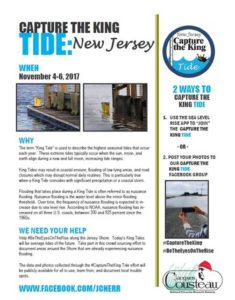 #CaptureTheKing
#CaptureTheKing
#BeTheEyesOnTheRise
PS: This could be a good local SJ Green Team or elementary school science class project. Tide Charts can be accessed online to guide the field work photos.
New Jersey’s Gubernatorial Elections are just a week away! Here are a few things to think about as you prepare to go to the polls.
I. New Jersey Ballot Question #2
In addition to voting for our next Governor, New Jersey voters will be asked to vote on Public Question #2, the “Revenue from Environmental Damage Lawsuits Dedicated to Environmental Projects Amendment” question.
The LRWP encourages New Jersey voters to vote YES on this important ballot question. A YES vote would require that Natural Resource Damages funds be used ONLY for their intended purpose of restoration and environmental cleanup. In years prior, more than 80% of supposedly dedicated environmental clean-up funds were instead appropriated for the state’s general operating budget.
According to the ballot question’s interpretive statement, “This amendment would dedicate moneys collected by the State relating to natural resource damages through settlements or awards for legal claims based on environmental contamination. These moneys would be dedicated to repair, replace, or restore damaged natural resources, or to preserve the State’s natural resources. The moneys would be spent in an area as close as possible to the geographical area in which the damage occurred. The moneys could also be used to pay for the State’s legal or other costs in pursuing the claims. Currently, these moneys may be used for any State purpose.”
For more information on Public Question 2 and its history and impacts, see https://ballotpedia.org/New_Jersey_Public_Question_2,_Revenue_from_Environmental_Damage_Lawsuits_Dedicated_to_Environmental_Projects_Amendment_(2017)
II. Questions for New Jersey Gubernatorial Candidates
Every Tuesday for the last 12 weeks the LRWP has reached out (via twitter) to the New Jersey Democratic, Republican, Green and Libertarian Gubernatorial candidates, posing questions specific to how they plan improve the health of our watershed and New Jersey environment. Only one candidate responded to any of our questions, but these are questions folks concerned about water quality and environmental health should ask of anyone running for public office. Here are the LRWP’s tweets, and the candidate responses:
7.25.2017
@PhilMurphyNJ @KimGuadagnoNJ @KaperDaleForGov@Pete4nj what actions would you take as Gov to make NJ’s water sector more energy efficient?
8.1.2017
@PhilMurphyNJ @KimGuadagnoNJ @KaperDaleForGov@Pete4nj do you support the use of citizen science as input into climate change modeling for the state of NJ?
8.8.2017
@PhilMurphyNJ @KimGuadagnoNJ @KaperDaleForGov@Pete4nj do you support implementing a state-wise water reuse assistance program?
8.15.2017
@PhilMurphyNJ @KimGuadagnoNJ @KaperDaleForGov@Pete4nj will you reinstate the 2007 flood hazard area control act rules?
8.22.2017
@PhilMurphyNJ @KimGuadagnoNJ @KaperDaleForGov@Pete4nj as Governor how would you encourage integrated watershed management in NJ?
8.29.2017
@PhilMurphyNJ @KimGuadagnoNJ @KaperDaleForGov@Pete4nj as Governor do you support the creation of stormwater utilities in NJ?
9.5.2017
@PhilMurphyNJ @KimGuadagnoNJ @KaperDaleForGov@Pete4nj do you support the use of citizen science as input into watershed modeling for the state of NJ?
9.12.2017
@PhilMurphyNJ @KimGuadagnoNJ @KaperDaleForGov@Pete4nj how will you position NJ to secure funding from USEPA revolving loan program for water & wastewater infrastructure?
9.19.2017
@PhilMurphyNJ @KimGuadagnoNJ @KaperDaleForGov@Pete4nj how does closing the water infrastructure investment gap play into your plans to create jobs & strengthen the economy?
9.26.2017
@PhilMurphyNJ @KimGuadagnoNJ @KaperDaleForGov@Pete4nj how will you help NJ’s towns secure funding from USEPA’s State Revolving Loan Program for H20 infrastructure improvements?
10.3.2017
@PhilMurphyNJ @KimGuadagnoNJ @KaperDaleForGov@Pete4nj as Gov, how would you help smooth the path to alternative financing & funding of H20 & wastewater infrastructure in NJ?
10.10.2017
@PhilMurphyNJ @KimGuadagnoNJ @KaperDaleForGov @Pete4nj do you support moving the state to 100% renewables by 2035?
10.24.2017
@PhilMurphyNJ @KimGuadagnoNJ @KaperDaleForGov @Pete4nj what commitment will you make to clean energy (tidal, solar, wind) in NJ?
Response from @KaperDaleForGov: We would commit to a Clean Power Plan with goals of dramatic increases in clean energy production by 2025.
See you at the polls!
Article and photos by Joe Sapia
Note: The yard references are to my house in the section of Monroe between Helmetta and Jamesburg in South Middlesex County. My yard is in a Pine Barrens outlier on the Inner Coastal Plain, the soil is loamy, and my neighborhood is on the boundary of Gardening Zones 6b (cooler) and 7a (warmer). Notes and photographs are for the period covered, unless otherwise noted.
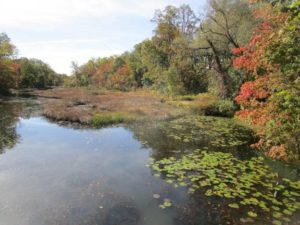
The fall foliage colors on Lawrence Brook in the Deans section of South Brunswick, Middlesex County.
FALL FOLIAGE: The peak of the colors is a little late this year, but this coming week should be very nice for viewing. The combination of fallen leaves and rain can make slippery driving conditions. So, be careful driving.
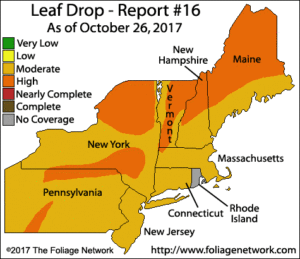
Northeastern United States fall foliage map. (Copyright 2017 by the Foliage Network.)
DEER RUT: Speaking of being careful when driving, look out for deer, “Odocoileus virginianus,” because the rut, or mating season, is on – meaning sex-crazed deer are running around. Normally, bucks stay out of sight, while it is common to see does and their brood. But over the last few weeks, I have noticed movement by bucks. During this week, I have seen a buck along the woods edge at Helmetta and in a driveway in a wooded area of East Brunswick, both in Middlesex County. If dividing the rut into three chapters of one, bucks challenging other bucks and chasing does, two, mating, and three, a wind-down, I would say we are in stage one on the cusp of stage two. The rut will extend to about mid-December.
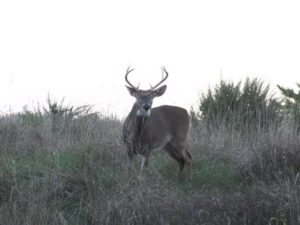
I shot this 7-point buck (with a camera) in 2015, October, just north of the Jersey Midlands near the Metropark railroad station area of Woodbridge, Middlesex County.
WINTER IS COMING: I have been gazing at the constellation Orion, easily identified in the night sky by its belt of three stars. When we can see Orion, it means we are in the colder weather part of the year. And cold weather means being on the lookout for snow. On 2008, October 28, it snowed in the Helmetta area of Middlesex County, but there was little, if any, accumulation. (The average snowfall in the New Brunswick, Middlesex County, area, for example, is 25.8 inches.)
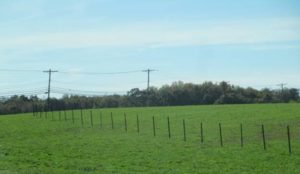
A sign of winter: fencing on farmland to prevent drifting snow. Here on a farm in Upper Freehold, Monmouth County, stakes for snowfencing are in place.
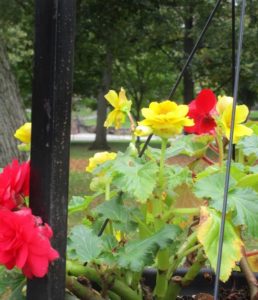
A little bit of lingering warm weather, a little taste of future cold weather — that is this time of year. Here, flowers in bloom on Voorhees Mall at Rutgers University—New Brunswick, Middlesex County.
“SNOWBIRDS”: Has anyone seen the first “snowbird,” or junco, “Junco hyemalis,” of the cold-weather season? I have not noticed any yet, but likely will see one soon, because I normally see the first one of the season around Halloween.
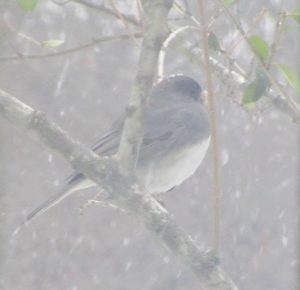
A “snowbird” in my yard in March of this year. They are a cold-weather bird in the Jersey Midlands. Normally, I begin seeing them around Halloween.
BIRD-FEEDING: For the first time in years, I did not feed birds this summer. Although I love zoning out and watching birds at my backyard feeder, I decided to put the birds visiting my yard to work, that is, eating insects – and from my end, saving money on birdseed. But this week, with food gardening pretty much over for the year and cold weather scaring off insects, I resumed feeding. It seemed to take a few days to attract birds to the feeder, but they are now there – blue jay, “Cyanocitta cristata”; chickadee, probably “Poecile carolinensis”; titmouse, “Baeolophus bicolor”; and nuthatch, “Sitta carolinensis.” And I await more species.
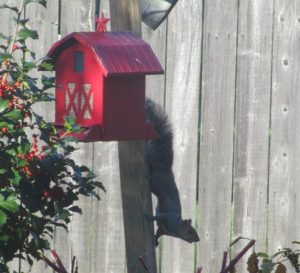
A gray squirrel, “Sciurus carolinensis,” testing the squirrel guard on my backyard birdfeeder. I will have to keep an eye on it to see who wins, feeder or squirrel.
DRY CONDITIONS: All of the Jersey Midlands’s seven counties are below average for rain over the last three months. Through October 27, Friday, Hunterdon received 8.5 inches, down 4.0 inches; Somerset, 9.6 inches, down 2.7 inches; Middlesex, 10.0 inches, down 2.1 inches; Mercer, 7.5 inches, down 4.5 inches; Monmouth, 8.2 inches, down 3.5 inches; Ocean, 9.0 inches, down 2.4 inches; and Burlington, 9.4 inches, down 2.4 inches.

Middlesex County’s Farrington Lake is low. Here, looking from the South Brunswick-East Brunswick boundary across the lake to North Brunswick.
THE WIND: On the morning of Tuesday, October 24, I went to the Helmetta Post Office, where I am third generation with Box 275, to pick up my mail. There, I noticed American flags at the Fire Department and at the historic Avon Inn snapping in the wind. Judging by the flags, the wind was blowing up to 8 to 12 miles per hour. Wind speed can be judged by its impact on flags, trees, and smoke, for example.
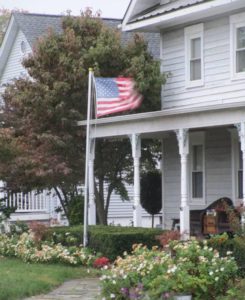
An American flag snaps to the wind at Helmetta’s historic Avon Inn, now a private residence. It dates back as a circa late 1800s-early 1900s inn positioned near a railroad station. (Think of the hotel on the 1963-1970 television sitcom “Petticoat Junction.”)
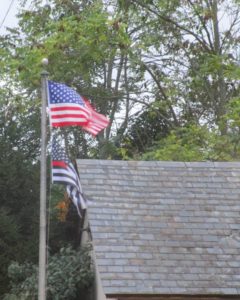
Another American flag in the wind at the Helmetta firehouse and old George W. Helme Snuff Mill pumphouse, which sits on the mill race leading from the former mill to Manalapan Brook.

This is an easy-to-use wind chart from universetoday.com. (Graphic copyright 2017 by universetoday.com.)
CLOUDS OVER NEW BRUNSWICK: During a break from my work in the Plangere Writing Center at Rutgers University’s Murray Hall in New Brunswick, Middlesex County, I looked out a window and noticed the clouds over the Johnson and Johnson pharmaceutical company headquarters along the Raritan River. Again, a beautiful display by Mother Nature:

Clouds over Johnson and Johnson pharmaceuticals headquarters along the Raritan River in New Brunswick, Middlesex County. Photograph from Murray Hall on the Rutgers University downtown campus.

Another photo of clouds over the J&J building in New Brunswick, Middlesex County.
LOST MAN IN THE PINE BARRENS AROUND HELMETTA: A 68-year-old was rescued after becoming lost and weakened during a walk in an East Brunswick, Middlesex County, section of the Jamesburg Park Conservation Area. The man apparently was not physically injured. But he had suffered a stroke about 10 years ago and has physical, cognitive, and speech limitations, according to family friends and officials. Rescuers first had to locate the man. Then, those rescuers were lost and had to be guided out of the woods. A State Police helicopter was called in to light up the woods and find the victim and his rescuers. The helicopter, then, guided them out before it had to leave because it was low on fuel. The rescue took about four hours until about 9:30 p.m. Because of the swampy and woodsy terrain, the man had to be hand-carried out on a stretcher. The Jamesburg Conservation Area, which is owned by Middlesex County Parks and Recreation, is about 1,400 acres of woods, swamp, waterways, and bodies of water, including Helmetta Pond.
HELMETTA POND, GOOD FOR THE SOUL: Ralph “Rusty” Richards, a mentor of mine in the Pine Barrens around Helmetta, Middlesex County, and I were talking at Helmetta Pond when this unfamiliar woman walked by and told us she was going to wet her feet in the Pond. It sure looked good for the soul.
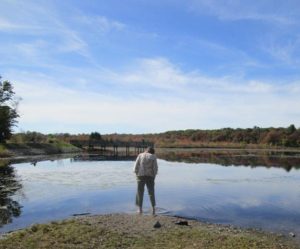
Wading woman at Helmetta Pond.
DRIVE-BY FARM SCENES: In my travels, I photographed various farm scenes in South Brunswick and Monroe, both in Middlesex County, and Upper Freehold, Monmouth County.
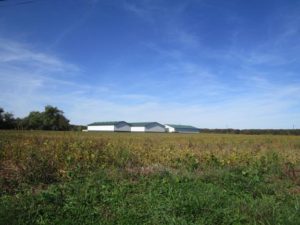
A farm in South Brunswick, Middlesex County.
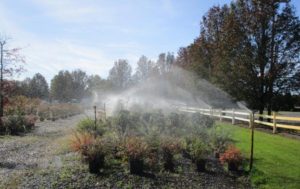
Lark Nurseries in Monroe, Middlesex County.
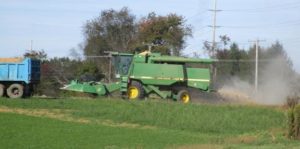
A combine works a field in Upper Freehold, Monmouth County.

Irrigation equipment on a sod farm in Upper Freehold, Monmouth County.
OCEAN TEMPERATURES: Atlantic Ocean temperatures on the New Jersey coast were about 61 degrees to 64 degrees on the October 28-29 weekend.
CHANGE THE CLOCKS: We switch from Daylight Savings Time to Standard Time November 5, Sunday, at 2 a.m., the clocks moving back to 1 a.m.
SUNRISE/SUNSET: For October 29, Sunday, to November 4, Saturday, the sun will rise about 7:25 to 7:30 a.m. and set about 5:55 p.m. For November 5, Sunday, to November 11, Saturday, the sun will rise about 6:35 a.m. set about 4:45 p.m.
WEATHER: The National Weather Service forecasting station for the area is at http://www.weather.gov/phi/.
THE NIGHT SKY: The next full moon is the Frost Moon on the Friday-Saturday, November 3-4, overnight.
“WAR OF THE WORLDS” BROADCAST: When you look into the night sky, something may be looking back… On 1938, October 30, Mischief Night, the Jersey Midlands were invaded by Martians in Orson Welles and the Mercury Theatre on the Air’s adaptation of H.G. Wells’s “The War of the Worlds.” The broadcast, https://www.youtube.com/watch?v=9q7tN7MhQ4I.
UPCOMING: October 29, Sunday, 1:30 p.m., from Clean Ocean Action: “There will be a commemoration of lives, homes and businesses lost as a result of (2012’s) Superstorm Sandy. There will be a rally followed by brief comments from various elected officials and the major candidates for Governor. Attendees will line the Asbury Park boardwalk from end to end demonstrating the urgent need to address climate change. The call to action will be captured by aerial photography as attendees hold hands across the boardwalk. For more information or to get involved, contact Ed Potosnak, NJ League of Conservation Voters at ed.potosnak@njlcv.org. RSVP today at njlcvef.org/sandy.”

A tree eats a traffic sign in South Brunswick, Middlesex County.
Joe Sapia, 60, is a lifelong resident of Monroe in South Middlesex County. He is a Pine Barrens naturalist and a gardener of organic vegetables and fruit, along with zinnias and roses. He draws inspiration on the Pine Barrens around Helmetta from his mother, Sophie Onda Sapia, who lived her whole life in these Pines, and his Polish-immigrant grandmother, Annie Poznanski Onda. He gardens the same backyard plot as did his Italian-American father, Joe Sr., and Grandma Annie. Both are inspirations for his food gardening. Ma inspires his rose gardening. Joe’s work also is at @JosephSapia on Twitter.com, along with Facebook.com on the Jersey Midlands page.
Except as noted, article and photos by Joe Sapia
Note: The yard references are to my house in the section of Monroe between Helmetta and Jamesburg in South Middlesex County. My yard is in a Pine Barrens outlier on the Inner Coastal Plain, the soil is loamy, and my neighborhood is on the boundary of Gardening Zones 6b (cooler) and 7a (warmer). Notes and photographs are for the period covered, unless otherwise noted.
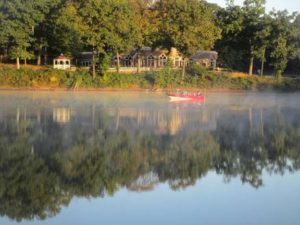
Morning on Farrington Lake, looking from East Brunswick to North Brunswick, both in Middlesex County, at the Hardenburg Lane bridge. Being on New Jersey’s Coastal Plain, where there are few, if any, natural bodies of water, Farrington Lake is created by the damming of Lawrence Brook between Davidson Mill Pond Park and Milltown.
FIRETOWERS: New Jersey’s fall wildfire season coincides with leaves falling and normally runs until about Thanksgiving and that time of year’s colder temperatures. But there could be a wildfire threat at any time if conditions are correct — and, now, we have had both falling leaves and dry conditions. So, the state Forest Fire Service is staffing its lookout towers. Visitors are welcome to go up in the towers when they are staffed – but, remember, you not only have to walk up the tower stairs, but you have to walk down. These Forest Fire Service towers are in the Jersey Midlands: Jamesburg/Middlesex County, Lakewood/Ocean County, Cedar Bridge/Ocean County, Medford/Burlington County, Lebanon/Burlington County, Apple Pie Hill/Burlington County, Batsto/Burlington County, and Bass River/Burlington County.
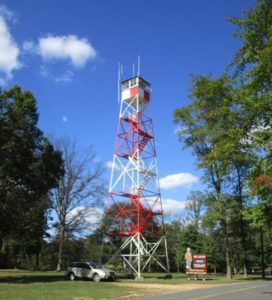
“Jamesburg Tower,” actually outside of Jamesburg in a Monroe Township section of Thompson Park, is about 65-feet-tall, sitting on high ground of about 150 feet above sea level over the Raritan River watershed.
GREAT HORNED OWL: Late at night, as I was at my desk, I thought I heard one of my favorite night sounds, the resonating hoot, hoot, hoot of a great horned owl, “Bubo virginianus.” I went outside and heard what I thought was a faint call of one, then nothing. The great horned is an early breeder, so the calling, signally both territory and looking for mates, should increase. More information, including audio of its calls, is at Cornell University’s All About Birds website, https://www.allaboutbirds.org/guide/Great_Horned_Owl/id.
BALD EAGLE, OCEAN COUNTY: Diane Larson, the home horticulturist and leader of the Master Gardeners program in Rutgers University’s Cooperative Extension Office/Monmouth County, sent in this photograph taken by her stepson, Danny Larson. It is a juvenile bald eagle, photographed on the afternoon of Thursday, October 5, on Beaver Dam Creek in Brick, Ocean County. Diane was leaning toward bald eagle, “Haliaeetus leucocephalus,” but raised a question if it could be a golden eagle, “Aquila chrysaetos.” Two New Jersey Audubon Society naturalists, Pete Bacinski (retired) and Scott Barnes (active) made the identification via this photograph. “It is a juvenile bald eagle,” Pete said. “The bill is too large for (a) golden.” “Yes, definitely a juvenile bald eagle,” Scott said. (Thank you, Danny, Diane, Pete, and Scott, for the team effort.)
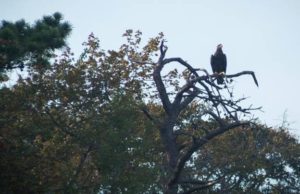
Danny Larson photographed this juvenile bald eagle on Beaver Dam Creek near his family’s house in Brick, Ocean County. (Photography copyright 2017 by Danny Larson.)
DRIVE-BY NATURALIST, DOUBLE-CRESTED CORMORANT: As I drive through the Pigeon Swamp area of South Brunswick, Middlesex County, I pass a warehouse area. There, I often see a double-crested cormorant, “Phalacrocorax auritus,” at a retention pond.

A double-crested cormorant in a retention pond in South Brunswick, Middlesex County.
STEAMING FARRINGTON LAKE: When water temperature is much warmer than air temperature, bodies of water look like steaming soup. I caught this view of Farrington Lake on a cool morning. A few winters back, when we experienced real cold temperatures, this phenomenon was seen at the Atlantic Ocean – a really cool view.
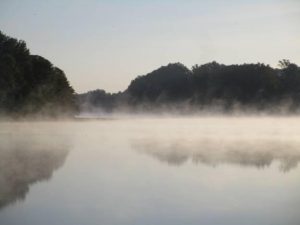
A steamy Farrington Lake, looking from East Brunswick to North Brunswick.
FALL ON THE FARMS: It is fall, so farms are displaying pumpkins and chrysanthemums. Field corn, or feed corn, awaits harvesting.
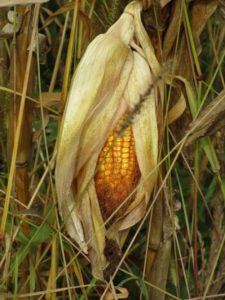
Field corn awaits harvesting in South Brunswick, Middlesex County
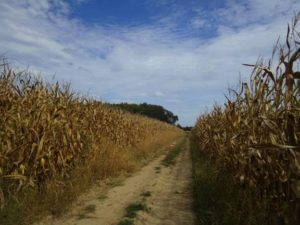
Acres of field corn await harvesting in South Brunswick
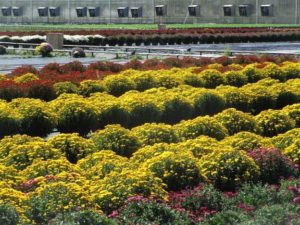
Chrysanthemums at Davino’s Nursery in East Windsor, Mercer County.
CLOUDS, NO. 1: One of the week’s beautiful clouds and sky view was from the East Windsor Community Garden in Mercer County.
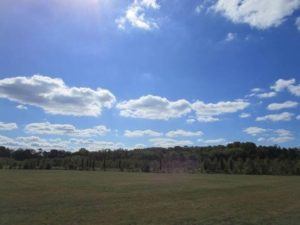
Beautiful clouds and sky view at East Windsor Community Garden in Mercer County.
CLOUDS, NO. 2: Another view of beautiful sky with clouds was from my backyard in Monroe, Middlesex County.

A clouds-in-the-sky view from my backyard in Monroe, Middlesex County.

Another clouds-in-the-sky view from my backyard.
OCEAN TEMPERATURES: Atlantic Ocean temperatures on the New Jersey coast were about 69 degrees to 71 degrees during the weekend of October 7 and 8.
SUNRISE/SUNSET: For October 8, Sunday, to October 14, Saturday, the sun will rise about 7:05 a.m. and set about 6:25 p.m. For October 15, Sunday, to October 21, Saturday, the sun will rise from about 7:10 to 7:15 a.m. and set about 6:10 to 6:15 p.m.
THE NIGHT SKY: The next full moon is the Frost Moon on the November 3-4 overnight.
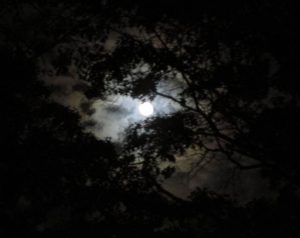
The moon over Manalapan Brook and its floodplain in Monroe, Middlesex County. This moon is waning after October 5’s Full Harvest Moon.
WEATHER: The National Weather Service forecasting station for the area is at http://www.weather.gov/phi/.

A view from Jamesburg Tower, looking south toward Monroe Township High School, from the spring of 2014.
Joe Sapia, 60, is a lifelong Monroe resident. He is a Pine Barrens naturalist and an organic vegetable-fruit gardener. He gardens the same backyard plot as did his Italian-American father, Joe Sr., and his Polish-immigrant, maternal grandmother, Annie Poznanski Onda. Both are inspirations for his food gardening. Joe is active with the Rutgers University Master Gardeners/Middlesex County program. He draws inspiration on the Pine Barrens around Helmetta from his mother, Sophie Onda Sapia, who lived her whole life in these Pines, and his Grandma Annie. Joe’s work also is at @JosephSapia on Twitter.com, along with Facebook.com on the Jersey Midlands page. Copyright 2017 by Joseph Sapia
Article and photos by Daniel Cohen, Rutgers University junior
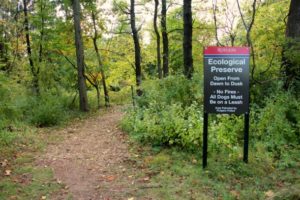
As a lifelong resident of Highland Park, and currently a student at Rutgers I have greatly enjoyed hiking throughout the university’s Ecological Preserve, a relatively pristine area located on the Livingston Campus. The Rutgers Preserve was established in 1976 as an ecological resource. Its purpose is to serve as an aesthetic, educational, and recreational area for the Rutgers community as well as for the residents of New Jersey. This 360-acre Eco-Preserve is the habitat of numerous creatures including migrant songbirds (warblers and towhees). It is also the home of the white-tailed deer. The Preserve is the site of native plants such as Spring Ephemerals and Jack-in-the-Pulpit, as well as Ash, Beech, Hickory, and Red Oak trees.
Anyone concerned with environmental matters in the Lower Raritan Watershed should be aware of the proposed Rutgers “Innovation Park” (IP) plan – an infrastructure project to be constructed adjacent to the Rutgers Eco-Preserve site. Rutgers has requested that the New Jersey Commission of Budgeting and Planning allocate $4.75 billion for infrastructure projects on its campuses as part of a Master Plan. Included in this proposal is funding for IP, a major project to be built on the edge of the Preserve. According to the Rutgers publication Business Plan and Implementation Strategy (2016), its purpose is to “promote research collaborations, technology transfer and commercialization, job creation, and public-private partnerships.” IP, an inter-disciplinary learning site with a goal of furthering environmentalism is well-intentioned.
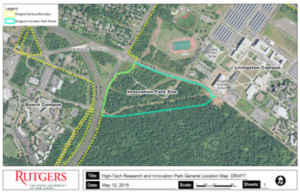
However, a project whose mission is environmental may nevertheless be harmful to the Preserve’s ecosystem. A major building project occurring just outside the Eco Preserve’s borders may well threaten fauna and flora within the Preserve itself. The project will result in pollutants from trucks and construction machinery as well as in greater noise levels. Fossil fuel emissions, the primary cause of climate change, have already caused the destruction of species of animals and plants worldwide. Excessive construction noise is harmful to the well-being of animals and plants as fossil fuel emissions and increased decibel levels will not stop at the Preserve’s periphery. The essential question is to what degree, the site will be impacted.
If it has not yet done so, Rutgers must conduct a thorough environmental review of the effects of this infrastructure project. Although in the Rutgers publication there is an environmental assessment of the IP site itself, there is no reference to its impact on the adjacent Eco-Preserve. There should be a comprehensive environmental assessment regarding how the IP project will impact this area. Residents of Central New Jersey and beyond, including members of the Rutgers community who care about protecting this vital habitat, must be given the opportunity to interact with those involved with this project.
Article and photos by Joe Mish
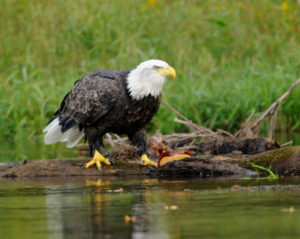
The food chain is not a one way street, as a turtle whose kin may feed on baby ducks, gets picked on by a bald eagle
It is unthinkable to imagine a restaurant where the diners are often listed as menu items. Though when seated at nature’s dinner table, the catch of the day takes on a whole new meaning as predators and prey freely alternate position. The dietary choices are also a surprise as the variety of delectable meals is often at odds with expectations.
Sorting through my library of photos, I was perplexed trying to categorize some images showing two species in close contact. Obviously notable was the reversal of who was eating who.
The first image which prompted these thoughts was captured as I launched my canoe. Here was a very young painted water snake, brilliant colored markings, with a fish sticking out its mouth. Comparing the size of the snake to the fish, I wondered if the snake ‘bit off more than he could chew’, as they say. The fish was wider than the snake and it didn’t look like much progress was being made in the attempt to swallow it. I couldn’t identify the species of fish but thought it a moment of karma as small mouth bass which inhabit the river are well known to forage on anything that swims or crawls in the waters of the south branch. A small snake would hardly be ignored by a hungry bass.
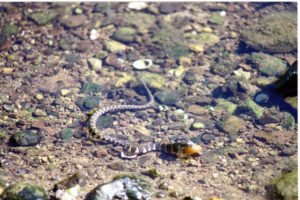
Another image shows a larger painted water snake suspended on o vertical river bank holding onto the tail of a gold colored catfish. As the snake was in an awkward position and didn’t want to go into the water, it was a standoff with the advantage going to the snake. The fish would struggle and then lay still. Eventually the fish broke free. I then remembered a series of images documenting another struggle where a snapping turtle grabbed a painted water snake by the tail. As I paddled along, I saw a water snake swimming across the river and as it neared the opposite bank it suddenly reared up and began to thrash about. Mystery solved as a snapping turtle soon surfaced holding on tight, as the snake now alternated struggling and lying still. As I drifted closer, the turtle was intimidated into releasing its grip and the snake swam off.
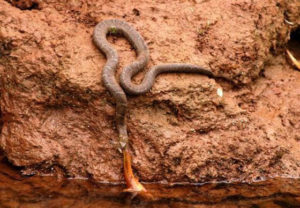
A painted water snake has a catfish by the tail. The snake is barely holding on to the vertical bank , using a tuft of grass to secure its precarious position. the catfish would struggle mighily and then rest. After several tries the catfish appeared dead and lay still for quite some time. Suddenly the catfish came to life and broke free. Again, the scene was captured from a canoe.
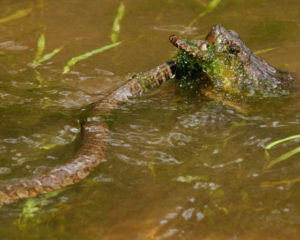
A painted water snakes has the tables turned on it as a snapping turtle reached up to grab the snake swimming across the river.
Turtles are not immune from the proverbial soup bowl as they are prey to many birds and animals that share the same habitat. Even large water snakes will easily swallow a turtle hatchling seeking cover in the water, as will great blue herons, mink, fox, skunk, raccoon and birds of prey.
In a twist of fate, the turtle that killed baby ducks in a farm pond yesterday could very well be on a larger bird’s menu today.
Such was the case when I spotted a bald eagle standing on a log near shore, intently pulling and tearing away at what was probably a deer carcass or white sucker. The eagle would occasionally look up and certainly it saw me from two hundred yards away, apparently not at all intimidated. As I closed the distance, a bright yellow object was clearly visible and the focus of the eagle’s rapt attention. I began to take photos, drifting ever closer and as I started to pass the eagle, it flew off. It was then I realized the eagle was dining on a painted turtle!
Across the land where rivers flow, the lines between predator and prey begin to blur. Don’t be surprised when a squirrel is seen carry a baby crow or a muskrat is swimming underwater holding a baby blue jay or a blue jay is flying off with a dead vole. If you can’t imagine it, it is happening somewhere along our wild rivers.

Muskrat with a bluejay swims into its den’s underwater entrance. Mystery for sure.
Author Joe Mish has been running wild in New Jersey since childhood when he found ways to escape his mother’s watchful eyes. He continues to trek the swamps, rivers and thickets seeking to share, with the residents and visitors, all of the state’s natural beauty hidden within full view. To read more of his writing and view more of his gorgeous photographs visit Winter Bear Rising, his wordpress blog. Joe’s series “Nature on the Raritan, Hidden in Plain View” runs monthly as part of the LRWP “Voices of the Watershed” series. Writing and photos used with permission from the author.
Article and photos by Joe Sapia
Note: The yard references are to my house in the section of Monroe between Helmetta and Jamesburg in South Middlesex County. My yard is in a Pine Barrens outlier on the Inner Coastal Plain, the soil is loamy, and my neighborhood is on the boundary of Gardening Zones 6b (cooler) and 7a (warmer). Notes and photographs are for the period covered, unless otherwise noted.

A bit of a strange scene in my backyard: forsythia blooming among the fall foliage changing of colors.
SPRING IN THE FALL: Years ago, I recall seeing sheep laurel, “Kalmia angustifolia,” a spring bloomer, flowering in the fall in the Pine Barrens around Helmetta. Twice this week, I noticed a bird or birds singing away, seemingly a springtime song; And a red-bellied woodpecker, “Melanerpes carolinus,” drummed against my house. Also, this week, I noticed another spring bloomer in flower – forsythia. It flowered in my backyard. I normally see forsythia blooming for the first time of the season in early March to mid-April. What does it all mean? I just think the fall conditions are replicating spring conditions, especially the summerlike temperatures.
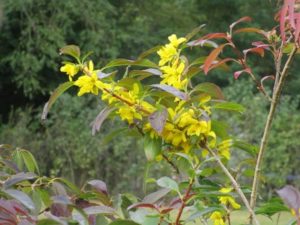
The backyard forsythia in bloom.
THE PINE BARRENS “FALL FOLIAGE” PEAK: The Pine Barrens’s name is a misnomer, neither a place of all pines nor barren lands. And it is a great place to see the changing colors of the fall foliage – the deciduous vegetation changes, with blueberry bushes turning flaming red, and contrasts with the greens of pines, cedars, and laurels. Normally, I look for the fall foliage color peak in the Pine Barrens on October 13 in the wetlands and October 20 in the uplands. This year, that schedule is running behind. The woods around Helmetta are still quite green. (“Fall foliage” is a misnomer, too. In the Pine Barrens around Helmetta, one can observe the changing colors beginning in about mid- to late July.)
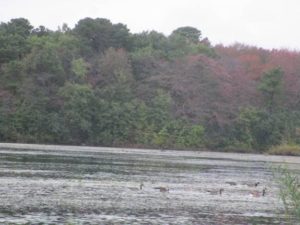
The colors are changing at Helmetta Pond October 13, Friday, but not yet peaking
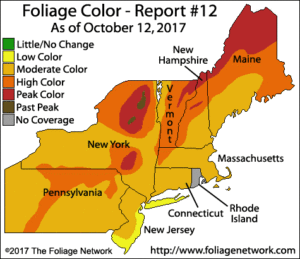
An October 12, Thursday, map from the Fall Foliage Network.
DRIVE-BY NATURALIST, PHEASANT: I just happened to be reading about ring-necked pheasants, “Phasianus colchicus,” the other day. Then, I saw one between the Applegarth and Wyckoff Mills section of Monroe, Middlesex County, the first time I recall seeing one afield in maybe 20 or 25 years. These are non-native – introduced to America from Asia in the 1880s, according to Cornell University’s All About Birds website, allaboutbirds.org. Now, they are naturalized in the United States. This one could have been a naturalized bird or one released for hunting.
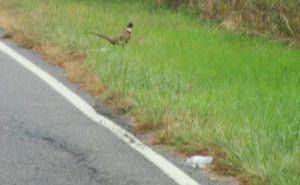
This is a rather blurry photograph, because I came across this ring-necked pheasant unexpectedly while I was driving and had to quickly crank off a photograph before it fled. I am using this photo because it shows a full view of the bird. Also, I did not crop out the roadside litter, to illustrate how wildlife competes with human carelessness.
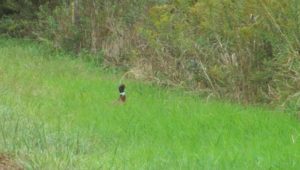
Notice the white, forming the ring around its neck.
CLOUDS: This week’s spectacular cloud scene was in Middlesex County, at North Brunswick, looking toward Milltown. I stopped at the McDonald’s restaurant for breakfast, looked at the sky, and there they were.
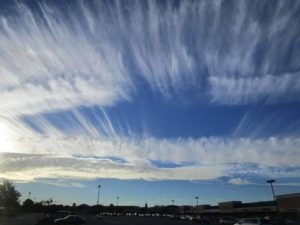
Clouds over North Brunswick, Middlesex County.
VOICES FROM (FAR) AFIELD, JUDY AUER SHAW: Judy Auer Shaw, author of “The Raritan River, Our Landscape, Our Legacy,” checked in from Ohio, reminded by a suggestion in a previous “Garden and Afield” to wear blaze orange in the woods in hunting areas: “I have a story from my teaching years in Michigan. I organized a nature hike for my kids (7th graders) and we all wore browns, grays and greens. As we approached the hiking trail, we were behind a carload of guys wearing orange. It finally dawned on me that we were going out on the first day of hunting season — in complete camouflage. Yikes! Needless to say, we were fine, but I was one worried den mother that day!”

Judy Auer Shaw’s 2014 book.
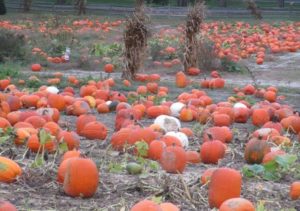
The pumpkin patch at Giamarese Farm on Fresh Ponds Road, East Brunswick, Middlesex County
YARD AND GARDEN: I planted five “false cypress,” or Crippsii,” I picked up at Krygier’s Nursery in South Brunswick, Middlesex County. The Knock Out roses and zinnias continue blooming – the zinnias being visited by such butterflies as the painted lady, “Vanessa virginiensis,” and cabbage white, “Pieris rapae.” Despite blooming, the zinnias are losing their luster, covered with powdery mildew, “Golovinomyces cichoracearum,” and a leaf spot disease. I also found my first raspberry on some bushes planted earlier this year.
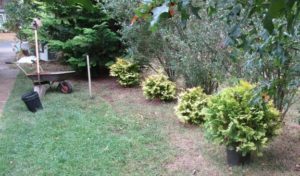
Five “false cypress,” or Crippsii, have been added to my yard.
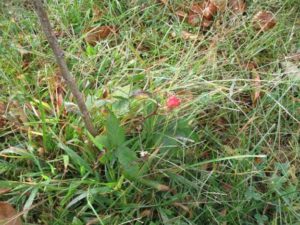
A raspberry fruiting in my backyard garden.
FARMING PERILS IN THE MIDLANDS: I was visiting Krygier’s Nursery, owned by husband and wife Jimmy Krygier, in South Brunswick, Middlesex County, and two perils were obvious – encroaching development and damage caused by browsing deer, “Odocoileus virginianus.” The nursery, a Krygier family business for three generations of about 100 years, is on Route 535, also known as Cranbury-South River Road, Cranbury Road, and South River Road. What was adjoining cornfield up to months ago is now a warehouse property, for example. And one only has to see how the deer have shaped the arbor vitae trees through their browsing. (Krygier’s Nursery is at the corner of Route 535 and Dunham’s Corner Road, South Brunswick, near the Middlesex County Fair Grounds).
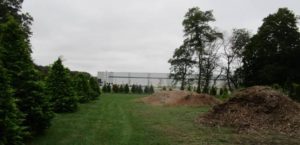
Development encroaches Krygier’s Nursery in South Brunswick, Middlesex County.
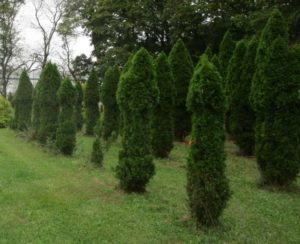
Notice the odd shape to the arbor vitae. It is caused by deer nibbling on the trees.
DEER DOCUMENTARY: “The Deer Stand” is a documentary about deer over-population in the Jersey Midlands. See the movie at https://vimeo.com/233572156.

In fall of 2016, Anna Luiten, an ecologist with the Monmouth County Park System, stands in a Thompson Park forest area over-browsed by deer. The fenced area contains a lush understory, because it is protected from deer.
SNOWBIRDS: Anybody seeing dark-eyed juncos, or “snowbirds,” yet? The birds, “Junco hyemalis,” come down to our area from as far away as Canada during the cold-weather months. I normally begin seeing them in my yard around Halloween. Their color pattern of slate gray on their backs and white on their fronts suggests, “Dark skies above, snow below.”
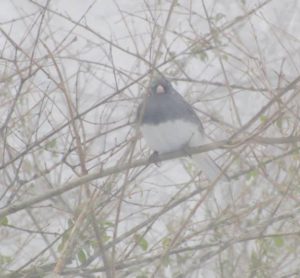
A “snowbird” in the snow in my yard in early 2017.
OCEAN TEMPERATURES: Atlantic Ocean temperatures on the New Jersey coast were about 67 degrees to 69 degrees during the October 14-15 weekend.
SUNRISE/SUNSET: For October 15, Sunday, to October 21, Saturday, the sun will rise from about 7:10 to 7:15 a.m. and set about 6:10 to 6:15 p.m. For October 22, Sunday, to October 28, Saturday, the sun will rise about 7:20 a.m. and set about 6 a.m. to 6:05 a.m. We switch to Daylight Savings Time November 5, Sunday, at 2 a.m., the clocks moving back to 1 a.m.
THE NIGHT SKY: The next full moon is the Frost Moon on the November 3-4 overnight.
WEATHER: The National Weather Service forecasting station for the area is at http://www.weather.gov/phi/.
UPCOMING: 2017, October 28, Saturday, 1 p.m. book signing and 2 p.m. lecture with Marta McDowell, author of “Beatrix Potter’s Gardening Life,” at Jamesburg Presbyterian Church, 175 Gatzmer Ave, Jamesburg. $30 at the door. More information is available from the Earth Center Conservancy (of Middlesex County), www.ecc-nj.com. Beatrix Potter, born in 1866 and died in 1943, was a children’s writer and illustrator. She wrote and illustrated “The Tale of Peter Rabbit,” 1901.

Author Marta McDowell will sign books and speak in Jamesburg, Middlesex County, October 28, Saturday.

Gray squirrels, “Sciurus carolinensis,” appear to be active, burying acorns, preparing for winter. This one was at Rutgers University’s College Avenue Campus in New Brunswick, Middlesex County.
Joe Sapia, 60, is a lifelong Monroe resident. He is a Pine Barrens naturalist and an organic vegetable-fruit gardener. He gardens the same backyard plot as did his Italian-American father, Joe Sr., and his Polish-immigrant, maternal grandmother, Annie Poznanski Onda. Both are inspirations for his food gardening. He draws inspiration on the Pine Barrens around Helmetta from his mother, Sophie Onda Sapia, who lived her whole life in these Pines, and his Grandma Annie. Joe’s work also is at @JosephSapia on Twitter.com, along with Facebook.com on the Jersey Midlands page.
Thursday October 12 is “Imagine a Day Without Water” Day. Can you even begin to imagine a day without water? It isn’t just your personal use of water – brushing your teeth, flushing your toilet, taking a shower – though those rituals are vital. Water is also essential to a functioning economy. What is a college campus or a hotel supposed to do if there is no water? They close. How can a restaurant, coffee shop, or brewery serve customers without water to cook, make coffee and beer, or wash the dishes? They can’t. And what about manufacturers – from pharmaceuticals to automobiles – that rely on water? They would grind to a halt too. An economic study released by the Value of Water Campaign earlier this year found that a single nationwide day without water service would put $43.5 billion of economic activity at risk.
Imagine a Day Without Water is an annual day of awareness that highlights the importance of safe, affordable water to all facets of everyday life. In recognition of the 2017 Imagine A Day Without Water, the Lower Raritan Watershed Partnership is unveiling our new “Community Resources for Water Quality” tool developed to improve the accessibility of information about preserving water quality for folks in the Lower Raritan Watershed. The “Community Resources for Water Quality” tool lists and describes publications and other types of materials available through the Rutgers-New Jersey Agricultural Experiment Station (NJAES) specific to maintaining or improving water condition in our communities. The tool is designed to assist Environmental Commissions, Green Teams and/or other interested residents to improve, preserve and restore stream areas and watersheds. We think it’s pretty neat!
Water is a public health issue, it is an economic issue. No community can thrive without water, and everyone deserves a safe, reliable, accessible water supply. Our new tool highlights things that every one of us can do to preserve and improve our water resources to make sure that no one ever has to imagine a day without water again. Please check out the tool, and let us know how it inspires you to preserve or restore our water resources!
With thanks to Rutgers-NJAES and Joan Kaplan with the Rutgers Environmental Steward program for their assistance in developing this tool.
Article by Billy Kurzenberger, Program Coordinator at City of Perth Amboy, Office of Economic and Community Development
The City of Perth Amboy, in partnership with the Rutgers Cooperative Extension Water Resources Program and with funding provided by the New Jersey Department of Environmental Protection (NJDEP), has launched several new projects in its community-based green infrastructure initiative, Perth Amboy SWIM (Stormwater Infrastructure Management).
Washington Park is the site of a new rain garden designed to redirect and absorb rainwater while beautifying the park. The park’s parking lot is now resurfaced in porous pavement designed to allow rain water to pass through the surface and seep into the ground instead of running off into our stormwater sewers.
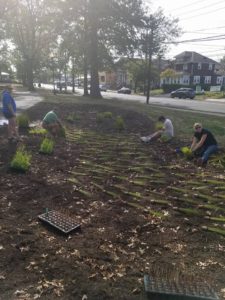
Perth Amboy SWIM rain garden installation, Sept 7/2017. Photo credit: Perth Amboy Mayor Diaz
In addition to the projects at Washington Park, the same partnership is responsible for the installation of two other porous pavement parking lots at municipal parking lot C on Jefferson Street and municipal parking lot RDH on Madison Street. All of these efforts will help us protect our local waterways from nonpoint source pollution, reduce flooding around the City and serve as excellent educational tools for the community.
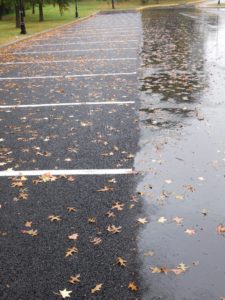
A Perth Amboy SWIM porous/pervious pavement Green Infrastructure project at Washington Park. October 9/2017 was the first rain. Rain water is allowed to pass through the asphalt & soak into the soil rather than flood the neighborhood. Photo Credit: Raritan Riverkeeper.
Perth Amboy SWIM meets on the third Thursday of every month at 10am and always welcomes new members! Meetings are held in the Brighton Avenue Community Center (56 Brighton Avenue, Perth Amboy, NJ). For more information, please contact Billy Kurzenberger at wkurzenberger@perthamboynj.org
Article and photos by Joe Sapia (except as noted)
Note: The yard references are to my house in the section of Monroe between Helmetta and Jamesburg in South Middlesex County. My yard is in a Pine Barrens outlier on the Inner Coastal Plain, the soil is loamy, and my neighborhood is on the boundary of Gardening Zones 6b (cooler) and 7a (warmer). Notes and photographs are for the period covered, unless otherwise noted.
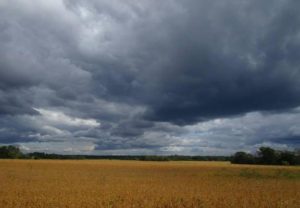
Gray clouds over Monroe farmland, looking toward the Jamesburg Park Conservation Area. Beautiful cloudy skies have presented themselves in recent years over my hometown of Monroe.
FALL HAS ARRIVED: Despite the summer-like temperatures the Jersey Midlands have been experiencing, fall is here. The calendar proclaims the beginning of fall at the September equinox – this year, September 22, when the day’s light and dark are generally equal. However, I regard fall beginning September 1 and running through October and November.
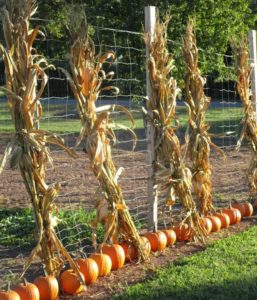
A fall scene at Griggstown Farm in Franklin, Somerset County.
DEER RUT: The mating season, or rut, for deer, “Odocoileus virginianus,” normally peaks from late October to mid-December. Here is Nixle.com-South Brunswick, Middlesex County, advisory:
“The South Brunswick Police Department is reminding motorists to be alert for increased deer activity over the next six weeks. This is typically when we see an increase in car crashes involving deer. The deer can unexpectedly dart onto roads so motorists need to use extra caution. “Motorists are urged to be especially attentive and cautious during morning and evening commutes when visibility may be poor. Deer are involved in thousands of collisions annually in New Jersey, with as many as half coming during the fall mating season, or rutting season…. An adult male deer can weigh 150 pounds or more.
“In the past month there have been a half dozen crashes involving deer in South Brunswick. In past years the majority of crashes have taken place over the next 6 weeks.
“…Deer are most active in the very early morning and around sunset, when visibility conditions can be very difficult. Using caution while driving will become even more important when Daylight Saving Time ends November 6, causing commutes to align with periods when deer are most active. For motorists, low levels of light and sun glare can make it very difficult to see deer that are about to cross the road. Moreover, multiple deer may cross the road at any given moment, usually in a single file.
The following tips can help motorists stay safe during from deer crashes:
-If you see a deer, slow down and pay attention to possible sudden movement. If the deer doesn’t move, don’t go around it. Wait for the deer to pass and the road is clear.
-Pay attention to ‘Deer Crossing’ signs. Slow down when traveling through areas known to have a high concentration of deer so you will have ample time to stop if necessary. If you are traveling after dark, use high beams when there is no oncoming traffic. High beams will be reflected by the eyes of deer on or near roads. If you see one deer, be on guard: others may be in the area. Deer typically move in family groups at this time of year and cross roads single-file. Don’t tailgate. Remember: the driver in front of you might have to stop suddenly to avoid hitting a deer.
-Always wear a seatbelt, as required by law. Drive at a safe and sensible speed, considering weather, available lighting, traffic, curves and other road conditions.
-If a collision appears inevitable, do not swerve to avoid impact. The deer may counter-maneuver suddenly. Brake appropriately, but stay in your lane. Collisions are more likely to become fatal when a driver swerves to avoid a deer and instead collides with oncoming traffic or a fixed structure along the road.
-Report any deer-vehicle collision to a local law enforcement agency immediately.
-Obey the state’s hands-free device law or, better yet, avoid any distractions by refraining from using cellular devices while driving.

I encountered these deer near Rutgers University–Douglass College in New Brunswick, Middlesex County. These are city deer, allowing me to get within 30 or so feet of them.
WEARING BLAZE ORANGE: With the popular deer-hunting season underway, it is probably a good time to wear blaze orange in the woods. Actually, a few years ago, I started wearing blaze orange on my knapsack year-round, because it is hard to keep track of hunting. During the last deer-hunting season, I walked under a tree-stand with a hunter, never seeing him until he spoke to me. Fortunately, I wore blaze orange. (The incident showed me, no matter a life spent in the woods, I let down my awareness.)

My blaze orange vest and one of my blaze orange hats.
BALDFACED HORNET NESTS: As we transition from the warm weather season to the cold, baldface hornets, “Dolichovespula maculate,” will abandon their nests. The abandoned nest is not a threat and may make a folksy bringing-of-the-outdoors-inside ornament. I have two hanging, with another waiting to be hung, in my cellar “cabin” area. Scope your nest now, but wait for colder weather to make sure it is fully abandoned. (Even in season, these nests are not a threat, if far-enough away from human activity. See this Pennsylvania State University Extension factsheet, http://ento.psu.edu/extension/factsheets/baldfaced-hornet.)
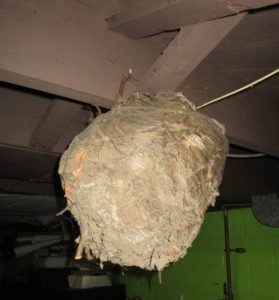
A baldfaced wasp nest on display in my cellar.
MONARCH BUTTERFLIES: Last week, I mentioned monarch butterflies, “Danaus plexippus,” would be heading on their southern migration to either Florida or, more likely, Mexico. The monarchs we see now are a “super generation,” the great-grandchildren of last fall’s migration and these making the complete trip south, if they survive. This week, I was able to photograph one in my garden as it visited the zinnias.
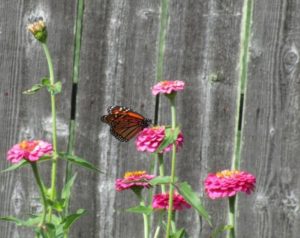
A monarch butterfly on the zinnias in my garden. If all goes right, this butterfly will migrate to at least Florida or, more likely, Mexico. Good luck!
ZINNIAS AND LETTUCE: This week, my zinnias went to Teddy’s luncheonette in Cranbury, Middlesex County, and the Hightstown Diner in Hightstown, Mercer County. The fall lettuce crop in my garden is growing nicely.

The fall lettuce crop in my garden.
GARDEN VOICES: Paul Migut, who gardens in South River, Middlesex County, checked in: “(I) pulled out all Rutgers and yellow tomatoes. (I) still have two grape/cherry tomatoes and two bush beans. And, of course, the ‘surprise’ turnips still growing. Enjoy the Fall season.”

Cherry tomatoes and bush beans from Paul Migut’s garden in South River, Middlesex County. (Photograph copyright 2017 by Paul Migut.)
BEAUTIFUL CLOUDS: The beautiful cloud formations continue. This week, among the places I photographed them was “Jamesburg Lake” (properly “Lake Manalapan”) on the Jamesburg-Monroe boundary, Middlesex County.
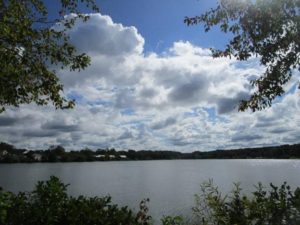
Clouds over “Jamesburg Lake,” Middlesex County.
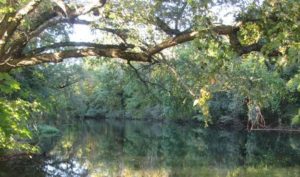
The Delaware and Raritan Canal on the boundary of Rocky Hill and Franklin, Somerset County.
OCEAN TEMPERATURES: Atlantic Ocean temperatures on the New Jersey coast were about 68 degrees to 70 degrees during the weekend of September 30-October 1.
SUNRISE/SUNSET: For October 1, Sunday, to October 7, Saturday, the sun will rise about 6:55 to 7 a.m. and set about 6:30 to 6:40 p.m. For October 8, Sunday, to October 14, Saturday, the sun will rise about 7:05 a.m. and set about 6:25 p.m.
THE NIGHT SKY: The next full moon is the Full Harvest Moon Thursday, October 5.
WEATHER: The National Weather Service forecasting station for the area is at http://www.weather.gov/phi/.
UPCOMING: Another “Rally for the Navesink” meeting is scheduled for Tuesday, October 3, 5:30 p.m., at the Monmouth Boat Club, 31 Union Street, Red Bank. The Rallies are an effort of environmental groups, the community, and municipal, Monmouth County, and state governments to promote improvement of the Navesink River in Monmouth County. The river suffers from high fecal bacteria counts and depleted oxygen levels. More information on the Rally is available from Clean Ocean Action, telephone 732-872-0111, website www.cleanoceanaction.org.
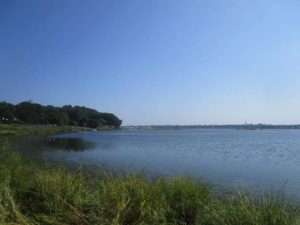
The Navesink River in September, looking downstream from Middletown toward Sea Bright, Monmouth County.

The recent photograph shows Sandy Hook, where the Atlantic Ocean and Raritan Bay meet, from an airplane flight leaving LaGuardia Airport in New York City. Humans, how small we are! (Photograph copyright 2017 by Dan Mulligan, a Long Branch, Monmouth County, kid who, now, lives in Cranbury, where he is on the Township Committee and has served as mayor.)
Joe Sapia, 60, is a lifelong Monroe resident. He is a Pine Barrens naturalist and an organic vegetable-fruit gardener. He gardens the same backyard plot as did his Italian-American father, Joe Sr., and his Polish-immigrant, maternal grandmother, Annie Poznanski Onda. Both are inspirations for his food gardening. Joe is active with the Rutgers University Master Gardeners/Middlesex County program. He draws inspiration on the Pine Barrens around Helmetta from his mother, Sophie Onda Sapia, who lived her whole life in these Pines, and his Grandma Annie. Joe’s work also is at @JosephSapia on Twitter.com, along with Facebook.com on the Jersey Midlands page.
 #CaptureTheKing
#CaptureTheKing





































































